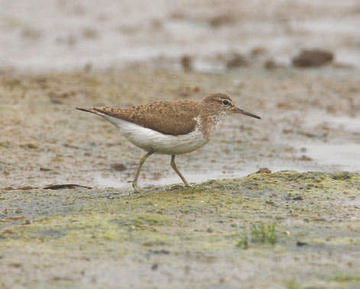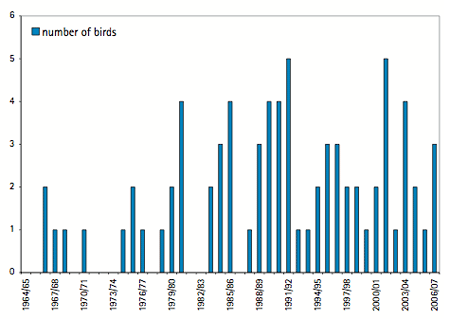
Common Sandpiper © Richard Steel
Most Common Sandpipers migrate to west Africa but odd birds are found here in winter. There is no evidence to show whether or not it is birds of our breeding population that remain here, but it is most likely that the wintering birds are breeders from farther north, or continental immigrants. The Fennoscandian breeding population numbers some half a million pairs (European Atlas), and they migrate in a south-southwesterly direction in autumn, bringing some of them to England (Migration Atlas).
The BTO Winter Atlas (1981/ 82 to 1983/ 84) found about 100 Common Sandpipers annually, with half of them in southwest England. It was noted that the national distribution of wintering birds was almost an exact reversal of their breeding situation, with virtually no overlap in the ranges. The same applies here at a local level, with none of the wintering birds found in the eastern areas of the county where they breed. Indeed, all of the winter records are close to sea level, five of them along the Manchester Ship Canal and the other next to the River Mersey. This also indicates a habitat shift, with almost all of the breeding birds being alongside standing water (lakes, reservoirs and sand-quarries) but the wintering records on flowing water.
The split is not as absolute as this description makes it sound, however, and in the last twenty years birds have been found in winter at several of the inland waters including Rostherne Mere, Pickmere, Hockenhull Platts and Arclid SQ, with occasional individuals along the River Dee.

Common Sandpiper wintering numbers.
Most Common Sandpipers in winter are solitary, but occasionally two or three can be found on the same stretch of canal, when they might defend a feeding territory. As in the breeding season, their diet comprises terrestrial and freshwater small invertebrates collected from the water’s edge. In both of these respects they are the opposite of most waders, flocking in large numbers on estuarine sites.
It would be expected that more birds would winter here in mild weather but so far there is no evidence of a correlation with winter temperatures. Records submitted to the annual Cheshire and Wirral Bird Reports over 43 winters from 1964/65 to 2006/07 show that wintering Common Sandpipers have totalled from none to five. The figures suggest that such records have become more common, but considering the increase in observers and their mobility, and the improvement in quality of optical equipment, the change in numbers of birds found does not seem striking.
Sponsored by Mike Allsopp

